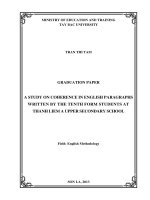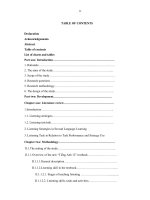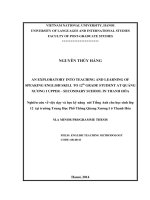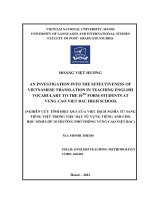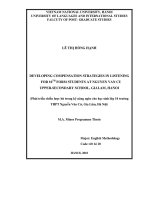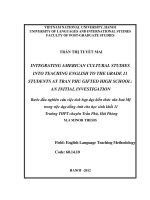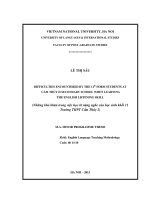The interference of the mother tongue in the writing skills of the grade 10 students at tinh gia 2 upper secondary school
Bạn đang xem bản rút gọn của tài liệu. Xem và tải ngay bản đầy đủ của tài liệu tại đây (342.47 KB, 60 trang )
VIETNAM NATIONAL UNIVERSITY, HANOI
UNIVERSITY OF LANGUAGES AND INTERNATIONAL STUDIES
FACULTY OF POST GRADUATE STUDIES
------
------
HÀ VĂN MINH
THE INTERFERENCE OF THE MOTHER TONGUE IN
THE WRITING SKILLS OF THE GRADE 10 STUDENTS AT
TINH GIA 2 UPPER SECONDARY SCHOOL
(ẢNH HƯỞNG CỦA TIẾNG MẸ ĐỐI VỚI KỸ NĂNG VIẾT CỦA HỌC SINH
LỚP 10 TẠI TRƯỜNG THPT TĨNH GIA 2)
M.A. Minor Programme Thesis
Field: English Teaching Methodology
Code: 60. 14. 10
Hanoi, 2011
VIETNAM NATIONAL UNIVERSITY, HANOI
UNIVERSITY OF LANGUAGES AND INTERNATIONAL STUDIES
FACULTY OF POST GRADUATE STUDIES
------
------
HÀ VĂN MINH
THE INTERFERENCE OF THE MOTHER TONGUE IN
THE WRITING SKILLS OF THE GRADE 10 STUDENTS AT
TINH GIA 2 UPPER SECONDARY SCHOOL
(ẢNH HƯỞNG CỦA TIẾNG MẸ ĐỐI VỚI KỸ NĂNG VIẾT CỦA HỌC
SINH LỚP 10 TẠI TRƯỜNG THPT TĨNH GIA 2)
M.A. Minor Programme Thesis
Field: English Teaching Methodology
Code: 60. 14. 10
Supervisor: NGUYỄN BÀNG, MA
Hanoi, 2011
iv
TABLE OF CONTENTS
DECLARATION………………………………………………………………………..
i
ACKNOWLEDGEMENTS…………………………………………………………….
ii
ABSTRACT…………………………………………………………………………….
iii
TABLE OF CONTENTS……………………………………………………………….. iv
LIST OF ABBREVIATIONS AND SYMBOLS……………………………………….
vi
LIST OF TABLES………………………………………………………………………
vii
PART A: INTRODUCTION……………………………………………………................
1
1. Rationale for the study…………………………………………………………… 1
2. Aims of the study ………………………………………………………………...
2
3. Research questions of the study…………………………………………………..
2
4. Scope of the study ………………………………………………………………..
2
5. Significance of the study …………………………………………………………
6. Organization of the study ………………………………………………………
PART B: DEVELOPMENT…………………………………………………………..
CHAPTER 1: LITERATURE REVIEW…………………………………………….
1.1.
Written language vs spoken language………
1.2.
The interference of L1 in L2…………………
1.3.
Errors in foreign language learning process…
1.3.1. Definition of errors……………………………………………………........
1.3.2. Errors and mistakes…………………………………………………………
1.3.3. Classification of errors ……………………………………………………..
1.4.
Contrastive analysis…………………………
1.5.
Error analysis…………………………………
1.5.1. Concepts of error analysis………………………………………………….
1.5.2. Procedures in analyzing errors……………………………………………..
CHAPTER 2: METHODOLOGY……………………………………………………
2.1. Research questions of the study………………………………………………..
2.2. Participants of the study………………………………………………………..
v
2.3. Data collection instruments …………………………………………………
20
2.3.1. Introduction to a test in general and description of the final test used in
the study……………………………………………………………………
20
2.3.2. Data collection procedures………………………………………………..
21
2.4. Coding the writtings…………………………………………………………...
22
CHAPTER 3: FINDINGS AND DISCUSSION……………………………………..
23
3.1. Data Analysis and discussion…………………………………………………..
23
3.1.1. Data Analysis and discussion on the errors from the test papers…………..
23
3.1.1.1. Identification……………………………………………………………
23
3.1.1.2. Description and discussion on the five most frequent types of errors….
23
3.1.2. Discussion and explanation on the grammatical errors……………………
29
3.2. Major findings………………………………………………………………….. 38
3.2.1. Major findings on how much MT interference in students’ errors…………
38
3.2.2. Major findings on the most frequent grammatical errors…………………..
39
3.3. Suggestions for further teaching strategies…………………………………….
39
PART C: CONCLUSION …………………………………………………………….
1. Summary of the
study…………………………………………………………….
2. Limitations of the study and suggestions for further
studies……………………..
40
40
41
42
REFERENCES………………………………………………………………………… I
APPENDIXES………………………………………………………………………….
APPENDIX 1………………………………………………………………………...
APPENDIX 2………………………………………………………………………...
APPENDIX 3………………………………………………………………………...
I
II
III
vi
LIST OF ABBREVIATION AND SYMBOLS
CA
: Contrastive Analysis
CS
: Correct Sentence
EA
: Error Analysis
EFL
: English as a Foreign Language
ES
: Error Sentence
L1
: First Language
L2
: Second Language
MT
: Mother Tongue
SLA
: Second Language Acquisition
TL
: Target Language
TG2USS
: Tinh Gia 2 Upper Secondary School
Ø : Missing word
vii
LIST OF TABLES
Table 1: Comparing spoken language and written language.
Table 2: Total number or errors from the test papers.
Table 3: Parts of speech in Vietnamese.
Table 2: Number or grammatical errors from the test papers.
1
PART A: INTRODUCTION
This part provides an overview of the study including the rationale, aims as well as the
research questions and scope of the study. Besides, the significance of the study and
organization of the study are presented.
1. Rationale for the study
In recent years, the teaching and learning of English have become a great concern in
Vietnam. English is now taught not only at all universities and colleges but also as a basic
and compulsory subject at all upper secondary schools, including TG2USS. Writing is one
of four skills in language learning process and it is seen as the most difficult and complex
language skill because it requires widely perception and needs good understanding on
grammar and structures.
Along with language knowledge and other three skills, writing is often required and
evaluated as a part of the total assessment of tests in two terms of the academic year of
upper secondary school. But there is a fact that students usually have a large number of
difficulties in expressing their ideas in their English writing. They normally translate word
by word, vocabulary, idiomatic expressions and especially grammatical rules of their first
language (L1) into the target language (TL). As a result, they do not often get good marks
or have good paragraph writings. These problems cause a lot of grammatical errors in
students‟ writing works. In other words, the students negatively transfer features of L1 into
the TL, and consequently they may encounter difficulties in learning English.
The better understanding of students‟ errors in EFL writing will help the students
recognize the negative effects of the mother tongue (MT) interference in L2 acquisition and
then avoid errors. It will also help students improve their accurate and fluent writing and
their English learning in the future.
All the above-mentioned reasons have inspired the researcher to carry out a study entitled
“The Interference of the Mother Tongue in the Writing Skills of the Grade 10 Students
at Tinh Gia 2 Upper Secondary School”.
2
2. Aims of the study
This study is primarily targeted at helping to improve the grade 10 students‟ writing skills
by reducing the negative interference of the L1 (Vietnamese) on their writing. To achieve
this aim, the researcher attempts:
-
To find out the most frequent L1 interference errors students committed when
doing paragraph writing.
-
To identify causes of the students‟ writing errors – the interference of the L1.
-
To give practical recommendations.
3. Research questions of the study
The study just focuses on writing errors caused by MT interference, the following research
questions are proposed:
1.
How much does L1 interfere with the students‟ writing?
2.
What are the most common L1- related grammatical errors committed by
the students in their writing?
4.
Scope of the study
The study was carried out with four classes (10C1, 10C6, 10C7 and 10C11) consisting of
182 students of TG2USS in their second term, the academic year 2010-2011. Due to the
fixed curriculum and limited time, the study only centred on the L1- related grammatical
errors committed by students in their final writing test papers and based on the analysis of
their writing papers, some suggested solutions were provided.
5. Significance of the study
The study attempts to bring about some benefits theoretically and practically to the readers
and researchers, especially to the secondary school teachers of English.
In terms of theoretical benefits, the study could provide the information on the students‟
errors in paragraph writing in teaching and learning process.
In terms of practical benefits, the researcher hopes that the study could be the references
for teachers of English and the readers as well.
3
-
The result of this study could provide the information and evaluation for the
students‟ knowledge of grammar, so they would avoid the same errors next time.
-
It would be useful for the teachers to improve the students‟ writing skills.
6. Organization of the study
The study consists of three parts: introduction, development with three chapters and
conclusion.
Part A, INTRODUCTION presents an overview of the study with the rationale, aims, the
research questions and scope of the study. Besides, the significance of the study and
organization of the study are presented.
Part B, DEVELOPMENT includes three chapters:
Chapter 1 presents literature review relevant to the study.
Chapter 2 consists of research questions, participants of the study, data collection
instruments and procedures of data collection.
Chapter 3 displays the major findings of the error analysis and discussions from the
collected data analysis. It also provides some suggestions for further
teaching strategies.
Part C: CONCLUSION presents a summary of the study. It also provides some limitations
of the study and suggestions for further study
The REFERENCES and APPENDIXES are at the end to the study.
4
PART B: DEVELOPMENT
CHAPTER 1: LITERATURE REVIEW
This part, literature review, presents a review of related literature that provides the
theoretical background of the study. It includes the main sections: section 1 dicusses the
written English vs spoken English, section 2 addresses the L1 interference on L2, section 3
examines errors in foreign language learning process, section 4 mentions contrastive
analysis (CA) and section 5, the last section, discusses error analysis (EA).
1.1. Written language versus spoken language
A commonly held belief is that the nature of written language will be most clearly seen
when being contrasted with that of the spoken language. Many famous linguists have
followed this approach such as Brown & Yule, Byrne, Ellis & Sinclair, etc. Brown & Yule
(1983) suggest that information is packed very much more densely in the written language
than in the spoken form, which also explains its brevity and results from the presence of
heavy premodified noun phrases, heavy adverbial modification and complex subordinating
phrases. In other words, the written language provides much more information than the
spoken language with a more complicated set of vocabulary and grammar rules.
Ellis & Sinclair (1989) make a clear distinction between spoken and written language.
They point out that written language is formal and stable while spoken language is
informal and variable. Therefore, it appears much easier to provide a model of written
language than that of spoken one. Done Byrne (1997) also agrees with the view that
writing is different from speech in a number of ways. Speech takes place against the
background of a situation and much of what we say can be understood from the situation;
speech is addressed to a person who is present at that time and there is continuous
interaction and feedback, which may be in verbal or non-verbal form. That is not to
mention the considerable amount of resources possible to be drawn from speech through
the use of prosodic features, facial expressions, gestures. Writing, in contrast, creates
contexts and is a way of communicating with someone who is not present and may not lead
to interaction. There is also no use of the prosodic features, which is replaced by
graphological devices such as punctuation and capitalization.
5
Ur, P. (1996:159-161) suggests nine characteristics that distinguish written from spoken
language. His analysis is summarized in Table 1:
Permanence
Explicitness
Density
Detachment
Organization
Slowness of
production, speed
of reception
Standard language
A learnt skill
Sheer amount and
importance
(Source: Adapted from Ur, P. 1996: 159-161)
Table 1: Comparing spoken language and written language.
According to the data, the different features between spoken and written language suggest
some cautions in teaching writing. Because written texts are permanent and can be referred
many times, they must be written with careful choice of vocabulary and structures.
6
1.2. The interference of L1 in L2
Many language teachers and linguists have considered L1 interference as an barrier of L2
learning. Lightbown and Spada (1993:54) found that in the 1960‟s various studies
indicated that most of mistakes L2 learners made due to their L1 interference. As a result,
numerous researchers have paid attention to errors which demonstrate the influence of
one‟s L1 on L2. Brown (1994:89) believes that SLA is strongly influenced by the learners‟
L1. He states “native language interference is surely the most immediately noticeable
source of errors among second language learners”.
Like Brown, Ellis (1995:19) points out:“It is a popular belief that second language
acquisition (SLA) is strongly influenced by the learner‟s first language (L1)”
In the article „„The Effect of The Use of L1 in a Multimedia Tutorial on Grammar
Learning: An Error Analysis of Taiwanese Beginning EFL Learners' English Essays‟‟ LiLing Chen (2006) points out that the L1 usage in CAI (computer assisted instruction) on
grammar did not yield a significant effect on grammar learning. However, by doing an EA
and CA between Mandarin and English, a number of grammar errors found were due to L1
interference. Chen identified eight error categories where the greatest number occurred in
his study: (1) verbs, (2) punctuation, (3) lexicon, (4) syntax, (5) capitalization, (6) subject
omission, (7) prepositions, and (8) articles.
Actually, in the process of learning a new language, the learners are often affected by their
MT. MT interference is due to the fact that learners convert the features of their native
language, for example, Vietnamese, into the TL - English. They tend to apply the
grammatical rules of their native language into the target ones. In her thesis Binh,T.T.H.
(2005:9) writes that learners tended to think in the L1 and attempted to put the idea in the
TL.
In his reference book (1990), Buu, H.V states that students‟ mistakes were originated from
Vietnamese interference. All the common errors of the Vietnamese learners of English
occurred in four areas: grammar ( parts of speech), word usage, sentence structures and
pronunciation. He also gives little explantion of how the errors arose or how far the
learners‟ poor English was influenced by their Vietnamese.
7
Mohideen, H (1996, cited in Maniam, M, 2010) agrees that MT interference is viewed as
one of the main causes of errors in writing among Malaysian students. He says that there is
MT interference in the areas of syntax, grammar, lexis and pronunciation. Wilkins ( 1972:
199) observes that:
"When learning a foreign language an individual already knows his mother tongue,
and it is this which he attempts to transfer. The transfer may prove to be justified
because the structure of the two languages is similar - in that case we get 'positive
transfer' or 'facilitation' - or it may prove unjustified because the structure of the
two languages are different - in that case we get 'negative transfer' - or
'interference'.
In other words, the influence of MT on L2 learning is manifested by the positive or
negative transference.This study does not explore the positive impact of the Vietnamese
language (MT) in learning a foreign language (English). It only concentrates on
investigating the negative effects of the MT in learning writing skills.
1.3. Error in foreign language learning process
1.3.1. Definition of error
In the history of English language teaching, numerous definitions of errors have been
proposed by many linguists and reseachers in terms of their differences. Corder (1973:259)
refers to errors as breaches of the code. Errors deviate from what is regarded as the norm.
In his research in 1998, James defines a languge error as an successful bit of language.
Dulay, et. al (1982:138) stress that errors are seen as “the flawed side of the learner speech
or writing, they are parts of conversation or composition that deviates from selected
norms”. Rechards, et al share the view that:
“ An erros in the speech or writing of a second or foreign language learners is the
use of a language item (e.g. a word, a grammatical item, a speech act, etc.) in a
way which a fluent or native speaker of the language regards as showing faulty or
incomplete learning”
Chun, A et. al (1982:538) also adorse this point that “an error is the use of a linguistic item
in a way which, according to fluent users of the language, indicates faulty or incomplete
learning”.
8
Similarily, other linguists have said that “an error occurs where the speakers fail to follow
the pattern or the manner of speech of educated people in English speaking countries
today” (Liski and Puntanen 1983:227). From these definitions, it is clear that an error is the
unsuccessful use of the TL in speech and writing by the learners in comparision with that
by the native speakers.
Nevertheless, Lennon (1991) states that such denitions are often ambiguous, because even
educated language teachers and native speakers often believe perfectly correct sentences to
contain errors (see also Hughes and Lascaratou 1982). Therefore, Lennon (1991:1982 )
claims to offer a more cautious definition, describing an error as:
“…a linguistic form or combination of forms which, in the same context and under
similar conditions of production, would, in all likelihood, not be produced by the
speaker‟s native speaker counterparts.”
In short, based on the above discussion, the researcher hopes to identify errors in the study
in the clearest way .
1.3.2. Errors and mistakes
Norrish (1983: 7) made a clear distinction between error and mistake. He states errors as a
„„systematic deviation when a learner has not learnt something and consistently „gets it
wrong‟.‟‟. Cunning Worth (1987) defines error as systematic deviations from the norms of
language being learned. It seems that the phrase “systematic deviation” in these two
definitions is a key word which can be interpreted as the deviation which happens
repeatedly. Chaudron (1986) reviews error as (i) “linguistic forms or content that differed
from native speaker norms or facts”, and (ii) “any other behaviour signaled by the teacher
as needing improvement”. George (1972: 2) gives a definition of “error” as “an unwanted
form, specifically, a form which a particular course designer or teacher does not want”.
Johansson (1975) believes that “If native speakers hesitate about the acceptability of a
word or construction it should not be considered an error”.
However, it is necessary to differentiate between error and mistake. Corder introduced the
distinction between systematic and non-systematic errors. Unsystematic errors occur in
one‟s native language; Corder calls these "mistakes" and states that they are not significant
to the process of language learning. He keeps the term "errors" for the systematic ones,
9
which occur in a L2. According to Corder (1974: 29), errors are typically produced by
people who do not yet fully command some institutionalized language system. A mistake is
also a deviation of the norms of the language but is not systematic. It means that the use of
the norm of the language in the sentences is sometimes right and sometimes wrong.
Norrish (1983:7) also says that a mistake is an inconsistent deviation that is sometimes the
learner „gets it right‟ but sometimes wrong. For example, if a learner has not yet been
taught a certain correct form and he uses one form sometimes and another at other times
quite inconsistently, „the inconsistent deviation‟ is called mistake. According to Richards,
et al. (1992:127), a difference between an error and mistake is that error results from
incomplete knowledge, whereas a mistake made by a learner when writing or speaking and
which is caused by lack of attention, fatigue, carelessness, or some other aspect of
performance.
From the linguists‟ opinions above, it can be concluded that a mistake is a non systematic
deviation from the norms of language. A mistake refers to the failures to use the language
system correctly caused by some factors such as carelessness, memory lapses, and physical
condition while error refers to the failure to use the system correctly caused by the lack of
the learners‟ competence, ignorance of appropriate rule and interference of the learners‟
MT and the general characteristics of the rule learning.
Error is a complicated concept by nature. However, for the purpose of this study, the
definitions by Norrish and Cunning Worth are adopted because these two definitions are
adequate to reveal the errors showing up in the written texts.
1.3.3. Classification of errors
According to James (1998:129), errors can be classified based on three criteria: modality,
medium and level.
Modality indicates whether the learners‟ behaviour is receptive or productive. By this
reference, there are receptive errors in listening and reading and productive errors in
speaking and writing.
Medium refers to whether the language received or produced is spoken or written. This
refers to errors made when the learner is operating with speech sounds (involving listening
and speaking or with written symbols (reading and writing). Taking modality and medium
10
together, we are able to specify which of the „four skills‟ the learner is operating at the
same time of the error: speaking, writing, listening or reading.
Level refers to on what level of language the learner is operating at the time he or she
makes the error. There are three levels of language errors: substance, text and discourse.
Substance errors: A misspelling is a substance level production error. There are other sorts
of substance errors besides misspellings that involve writing. They are referred to as
mechanical errors, including punctuation errors, typographic errors, dyslexic errors and
confusables.
Text errors: include lexical and grammatical errors.
Discourse errors: cover inappropriate coherence, pragmalinguistic and receptive.
Regarding writing errors, according to James (1998:130), only misspelling (substance
errors), lexico-grammar (text errors) and inappropriate coherence (discourse errors) are
involved. However, due to the limited time and the purpose of the study, misspellings
(substance errors) and inappropriate coherence (discourse errors) will not be discussed in
this study.
Text errors:
Text errors are errors that derive from misapplication of the lexico-grammatical rules of the
language. That is to say, this type occurs when a learner fails to apply the rules completely,
including how these rules are exploited to achieve texture.Text errors consists of lexical
errors and grammar errors. However, only grammar errors will be discussed in the study.
Grammar errors
According to James (1998:154), grammar has traditionally been discussed in terms of
morphology and syntax, the former handling word structure, the latter dealing structures
“larger” than the word
(i) Morphology
James concludes that morphology error as a failure to comply with the norm in supplying
any part of any instance of the word classes (noun, verb, adjective, adverb, and
preposition). Below are the examples of morphology errors.
11
- Noun
- Verb
- Adjective
These errors are basic but persistent, regularly resurfacing even in the EFL writing of PhD
students (James, 1998:155).
The most popular are third singular “s”, plural “s”, past tense “ed”, and progressive “ing”.
About adjective morphology errors, eg: using colourfuller (instead of colourful) scene or
visit me soonly (soon) is an example of adverb morphology errors
(ii) Syntax errors
Syntax errors are errors that affect texts larger than the word, namely phrase, clause,
sentence and ultimately paragraph. Below are the examples of syntax errors.
Phrase structure errors: at phrase level, James (1998:157) suggests using the tripartite
structure: modifier + head + qualifier (MHQ) in which M and Q can be refined in terms of
positional subclasses m1, m2, m3… and q1, q2, q3, etc. For example:
Errors
He is a cleverest boy in
the class
He no can swim
That fat big fish is the
mama fish
Clause errors: while phrase errors involve violation in the internal relations between parts
of phrases, clause errors involve whole phrase – themselves well-formed – entering into the
structure of clauses. Deviance will arise where any one of five condition holds:
12
Errors
He shaved himself the
beard.
Give ø to the dog!
Watson sent to him the
letter.
He seems crying.
You would be most likely
get first prize.
Sentence errors: These involve the selection and combination of clauses into larger units.
Other sentence errors are consolidation errors, comprising the two sub-types coordinate
and subordination errors ( Shaughenessy, 1977:55)
They believe [they can become leaders in their field1] and [a good secure2].
The two conjuncts are not equals: in fact the first is a clause and the second an NP. What
they have in common is that both are objects of the verb believe.
a. Gandhi, who led the independence movement in India, was a politician
b. Gandhi, who was a politician, led the independence movement in India
They contain the same information, but it is differently packaged and differently valued in
each.
Intersentence errors (Cohesion): to be identified with five types of codesive link of text
structure: referece, substitution, ellipsis, conjunction and lexical cohesion.
Jim insists that there is a beast. Jack being controlled by this fear.
There is no obvious referent of “this fear”.
Simon is also a Christ like figure. We see it in the way he gave his food to Piggy.
Simon is also a Christ like figure. We see this in the way he gave his food to Piggy.
By the same token if you are too old I am too old also.
If you are too old, by the same token I am too old also.
13
1.4. Contrastive analysis
CA (Contrastive Analysis, Benjamin Le Whorf 1941 ) is also termed as CLA (Contrastive
Linguistic Analysis, Fries 1945) or CAH (Contrastive Analysis Hypothesis, Brown 1980).
A number of fundamental and applied objectives have traditionally been attributed to CA.
The first one is to discover similarities and differences between languages. The second is to
explain and predict problems in L2 learning. The third objective is to develop course
materials for language teaching.
During the last decades, a systematic CA has been advocated as a means of predicting the
difficulties in learning a foreign language. It is now realized that CA should be used to
explain difficulties. In other words, CA should be used as part of the explanatory stage in
EA. It can help explain some of the errors actually committed by learners after these errors
have been observed.
CA is the basic approach used to study L1 interference. According to Richards and Schmidt
(2002), CA focuses on the comparison of the linguistic systems of the two languages,
especially the sound and grammar systems of L1 and L2, to find solutions to L2 instruction
problems. CA was developed and practiced in the 1950s and 1960s, as an application of
structural linguistics to language teaching. It is based on the following assumptions: (i) the
main difficulties in learning a new language are caused by interference from the L1 or
„language transfer‟, (ii) such difficulties can be identified by CA, and (iii) teaching
materials can make use of CA to eliminate the interference effects.
CA stressed the native language as the main factor affecting L2 learners‟ errors. In other
words, CA emphasizes the interference of the MT in learning a L2 in phonological,
morphological, lexical and syntactic level. It holds that L2 would be affected by L1. Here,
language is taken as a set of habits and learning as establishment of new habits, a view
sprung from behaviorism, under which language is essentially a system of habits. In the
course of language learning, L1 learning habits will be transferred into L2 learning habits.
Therefore, in the case of L1 transfer into L2, if structures in the MT have their
corresponding structures in the TL and L1 habits can be successfully used in the L2,
learners would transfer similar properties successfully and would result in positive transfer.
Contrastingly, in the case of negative transfer or interference, certain elements of the MT
14
have no corresponding counterparts in the TL, L1 habits would cause errors in the L2, and
learners would transfer inappropriate properties of L1.
1.5. Error analysis
1.5.1. Concepts of error analysis
Error analysis (EA) is a type of linguistic analysis that focuses on the errors committed by
learners. According to Richards, et al. (1992:127), the study an analysis of errors made by
the L2 learners is called EA, which is carried out in order to identify strategies learners use
in language learning, try to identify the cause of learners‟ errors, and obtain information on
common difficulties in language learning, as an aid to teaching or in the preparation of
teaching materials.
James (1998:1) says that EA is the process of determining the incidence, nature, causes,
and consequences of unsuccessful language learning. Cook (1993: 22) points out, EA is “a
methodology for dealing with data, rather than a theory of acquisition”. The data can be
taken by conducting a test with the students as the respondents. Brown (2000:218) gives a
complete definition of EA in the following way:
“the fact that learner do make errors and that these errors can be observed,
analyzed, and classified to reveal something of the system operating within the
learners, led to surge of study of learners‟ errors, call error analysis”.
It seems this concept is the same as the one proposed by Crystal (1987:112), EA is a
technique for identifying, classifying and systematically interpreting the unacceptable
forms produced by someone learning a foreign language, using any of the principles and
procedures provided by linguistics.
EA developed as a branch of applied linguistics in 1960s, and set out to demonstrate that
learners‟ errors were not due to the learners‟ MT but reflected universal learning
strategies. EA, therefore, offered as an alternative to CA, has its value in the classroom
research. CA, which may be least predictive at the syntactic level and at early stages of
learning languages (Brown, 1994:214), allows for prediction of the difficulties involved in
acquiring a L2 (Richard, 1974:172) whereas EA emphasizes “the significance of errors in
learners‟ inter-language system” (Brown, 1994:204), may be carried out directly for
pedagogic purposes (Ellis, 1995:51)
15
EA does not focus only on the interface between MT and L2, but also on other sources of
errors. EA became distinguished from CA by its examination of errors attributable to all
possible sources, not just those which result from negative transfer of the native language
(Brown & Douglas, 1994:206).
1.5.2. Procedures in analyzing errors
Various researchers in the field of linguistics have attempted to establish their own models
for EA procedures. One of the most frequently mentioned models by numerous other
authors in the same field such as Richards, et al (1992), Ellis (1995:51-52), Brown
(2000:207-211) is Corder‟s model (1967 & 1974). Corder identified a model for EA which
included three stages: (i) Data collection: Recognition of idiosyncracy; (ii) Description:
Accounting for idiosyncratic dialect; (iii) Explanation (the ultimate object of EA).
In 1984, Van Els, et. al propose a model for EA procedures including six steps: A corpus of
language is selected, the errors in the corpus are identified, the errors are classified, the
errors are explained, the errors are evaluated, prevention or correction of errors.
James (1998) suggests a more detailed model for EA procedures. Basically, his model
follows the same steps as Van Els, et. al (1984). However, Jame‟s model emphasizes
detailed description of errors. His description of errors in three levels of errors mentioned
in section 1.3.3, namely modality, medium and level. They seem very useful and easy to
understand for many studies, including the researcher.
According to Ellis and Barkhuizen (2005), there are five steps in conducting any EA study:
(i) Collection of a sample of learner language; (ii) Identification of errors; (iii) Description
of errors; (iv) Explanation of errors, and (v) Error evaluation.
The models for EA procedures mentioned above, in which the model by Ellis and
Barkhuizen (2005) is selected for this study because it is described in a very easy way to
follow. Nevertheless, the last step - error evaluation is not carried out due to the limited
time and the scope of the study. The other steps are described and discussed as follows.
16
(i) Collection of a sample of learner language.
The first point in EA is the collection of a sample of learner language. Van Els, et al (1984)
states the the sample of learner language ( or corpus of language) should involve deciding
on the size of the sample, the medium to be sampled and the homogeneity of the sample
(by taking into account the learner‟s characteristics: age, stage of development, motivation,
etc). Corder (1974) proposes four points to pay attention to when collecting samples as
follows:
First, it is necessary to identify the size of the sample. Researchers have identified three
broad types of EA. These types are: massive, specific and incidental samples.
Second, it is very vital to collect well-defined samples of learner language so that clear
statements can be made regarding what kinds of errors the learners produce and under what
conditions. The reason for this matter lies in that the errors that learners commit can be
influenced by a lot of factors. For example, they may commit errors in speaking, not in
writing, as a result of the different processing conditions involved.
Third, the researcher decides the manner in which the samples are to be collected. In these
samples, learner language either reflects natural, spontaneous language use or is elicited in
some ways. Natural samples are generally preferred but learners often do not produce
much spontaneous data. Therefore, elicited data is argued to be the case. The research
identified two kinds of elicitation:“Clinical elicitation” and “Experimental methods”.
However, the identification of error elicitation stated above is not strong enough to clarify
which data collection instruments to be used for the research. James (1998) suggests three
kinds of elicitation techniques: observational techniques, experimental techniques and
introspection. Observational techniques are believed to reside mainly in naturalness while
experimental techniques reside in manipulative nature.
Observational techniques are conducted with such classroom activities as role play,
information gap activities, simulations, involving pairs and groups of learners.
Classroom observation is also one of the observational techniques, using observation sheet.
Experimental techniques are used by contrast interventionist. They take the learners aside
and give them tasks to do, the sole purpose of which is to elicit targeted forms which the
error analyst is interested in. Experimental techniques include simple imitation, stimulus
17
modification and controlled elicitation. Among these, controlled elicitation involves the use
of cloze tests, dictations and even multiple choice tests. The third kind of elicitation
techniques is introspection. This approach means getting the learner‟s cooperation to
discover what is going on in the language learner‟s mind. Introspection is carried out using
learner diaries, questionaires and language judgment tests.
Among these techniques of elicitation, observational techniques using classroom activities
seem to be preferable in speaking EA. Therefore, in this study, the researcher decided to
use one of experimental techniques. A test was used to investigate different types of errors
which students at TG2USS made and possible causes of these errors.
Finally, the researcher should decide “whether the samples of learner are collected crosssectionally (i.e. at single point in time) or longitually (i.e. at successive points over period
of time)”. Longitudial collection is better but time-consuming than cross-sectional one.
Due to the limited scope and time for this study, a massive sample for this study was
collected cross-sectionally using the techniques mentioned above.
(ii) Error Identification
According to Corder (1974), the second step of EA procedures - identification of errors, the
researchers need to “decide what constitutes an „error‟ and to establish a procedure for
recognizing one”. He suggests four crucial questions that should be clarified when
recognizing an error.
The first question is to set up what TL should be used as the point of evaluation for the
study. Generally, in order to describe writing errors, Corder suggests choosing the standard
written dialect as the norm where classroom learners are concerned. Burt and Kiparsky
(1974) also stated that “we should identify errors by reference to the TL, according to what
person who says them has learnt about English”.
The second is related to the differences between “errors” and “mistakes or slips”. An error
is made when the deviation arises as a result of lack of knowledge while a mistake or slip
occurs when learners fail to perform to their competence in the TL. Normally, a mistake or
slip is immediately corrected by the learner.
The third one is about interpretation. There are two kinds of interpretation: overt and
covert. The former is easy to identify because there is a clear deviation in form (She selled
18
her car) and the latter occurs in utterances that are syntactically and semantically wellformed but pragmatically odd (Where do you go?). James (1998:68) states if an error
touches the grammar, it is overtly error. Whereas touching the acceptability of meaning, it
is covertly error.
The last one is focused on deviations. There are two kinds of deviation: correctness and
appropriateness. Their difference is very simple: the first is a deviation of the rules of the
language usage (I did ate with her) and the other is a deviation of the language use (she
can to do whatever she wants).
In this study, the esearcher used two kinds of books as the norms. They are “A University
Grammar of English” by Quirk and Greenbaum(1976) and “English Grammar in Use” by
Murphy (1994).
The distinction between errors and mistakes, overt and covert errors is not taken into
consideration in this study. All the errors in the study were identified in terms of both
correctness and appropriateness.
(iii) Description of errors.
According to Corder (1974), the system used for the desription of learners‟ errors must be
one having two essential characteristics. First, the system must be well-developed and
highly elaborated because many errors committed by even beginning learners are
considerably complicated: it is not the case, as one might expect, that only advanced
learners make advanced errors, since even many errors committed by beginners are serious.
Second, it should be as simple, self-explanatory and easily learnable as possible.
According to James (1998: 96-97), there are three main purposes of the description stages:
(1) to make the errors explicit; (2) it is indispensable for counting errors, and (3) it is a
basis for creating categories. In other words, James points out that one of the basic
purposes of error description is that this stage reveals which errors are different or the
same, and this is the necessary step in putting them into categories. In this study, the error
classification by James is used to identify and categorize errors found in the test papers.
This error classification has been pesented in section 1.3.3.
